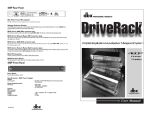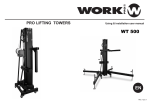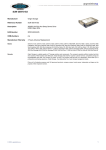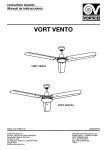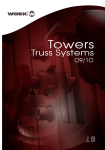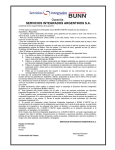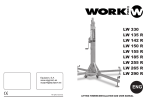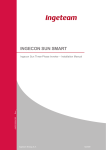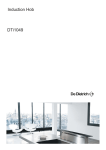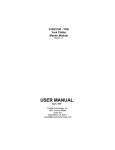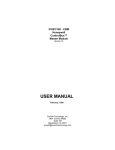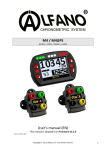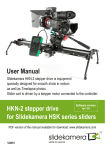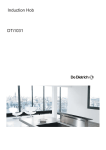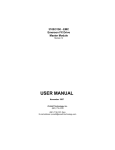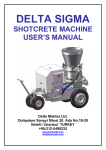Download LW 480 R WT 600 LW 465 R EN
Transcript
PRO LIFTING TOWERS Using & Installation user manual LW 465 R LW 480 R WT 600 EN Rev. 12.5.6 LW 465R/480R/WT 600 LIFTING TOWERS INSTALLATION AND USER MANUAL LW 465 R LW 480 R WT 600 LW 465R/480R/WT 600 LIFTING TOWERS INSTALLATION AND USER MANUAL INTRODUCTION 1 FEATURES 2 SPECIFICATIONS 3 FASTENER SYSTEM (explanation) 3 SAFETY RULES 5 INSTALLING THE LIFTING TOWER 9 PLACING THE LOAD 10 WINCH OPERATION (Special care) 13 LIFTING PROCESS 14 DESCENT/FOLDING PROCESS 16 CONFORMITY DECLARATION 19 BGV C1, EXPLANATION & TEST 20 FEATURES INTRODUCTION 2º LW 465R and LW 480R are the new lifter towers of WORK® One serial of towers produced in steel and entirely safe. They are able to lift loads all straight from the soil up to a height of 8 m (LW 480 R) or 6,5 m (LW 465 R), without any effort for the user. These towers have a different number of profiles with the goal of reaching the maximum elevation (5 sections for LW480 R and 4 for LW465R). It special design reaches a total reliability due to its multiple security systems, locking system or independent blocking pins for each section. As usual in WORK® products, all the components have been oversized with the goal of achieving a superior security: - High resistance aluminium profiles. - Powerful autoblocking bolts. - Steel made pulleys. - Autoblocking certified winches. These towers have a light inclination (2º) over the vertical axis in order to displace the gravity centre to the opposite side of the load, getting a better balance with the coupled load. For the transport, LW 465R and LW 480R incorporate a folded wheel system. - 2 iron braces placed in the back side to reinforce. - Bubble level indicator vial - High resistance legs. - Strong cable of security made of steel under the DIN normative With this system, is posible to make more easy the transport process in a lorry or track, the wheel allow to lean the tower over the lorry base and to displace it So the winch does not suffer scratches or hits. WT 600 Taking adxperience and good sucess obtained in effectiveness, security and endurance with the system used in our Series 400 Lifting towers, we have develop WT 600 for the elevation of Line Array systems. The transverse pieces placed between the base and mast provide an extra firmness Additional wheels for an easy load up or get down process from a lorry or track. (Only LW 400 series) Its innovate design in the profiles section, allowsto this lifting tower, the elevation and supportof heavy loads (up to 350 Kg) to a maximum height of 6 m., Making them very adecuate for big complexity shows. The ground strenthening system has been conscientiously studied, providing to the tower of a sujection legs of high length with inclinated stabilizers. To carry on system designed for Line Array support has been reinforced taking in account the exerted force, so the thickness of metallic walls and sujections rings, is superior, incroporating also an angle finishing that allows to give out the load over the whole support in equitable way. Fork carrier profile in order to support the elevated load. IMPORTANT For WT 600 model. ALL DRAWINGS IN THIS USER MANUAL ARE BASED ON LW 480R LIFTING TOWER. THE MODELS LW 465R & WT 600 INCORPORATE THE SAME OPERATION METHOD. INSTALLATION AND USER MANUAL LW 465R/480R/WT 600 LIFTING TOWERS 1 INSTALLATION AND USER MANUAL LW 465R/480R/WT 600 LIFTING TOWERS 2 SPECIFICATIONS MAX LOAD (KG) MIN LOAD (KG) DISPLAYED TOWER HEIGHT (M) SPECIFICATIONS Standards and Regulations applied on winches incorporated on each lifting tower. FOLDED TOWER BASE (M) HEIGHT (M) BASE (M) WEIGHT (KG) LW 465 R 370 30 6,5 2,30 x 2,00 2,20 0,70 x 0,60 200 LW 480 R 320 30 8,0 2,30 x 2,00 2,20 0,70 x 0,60 220 WT 600 350 30 COMPOS. (GALVANIZED) 6,5 Ø (mm) 2,00 x 1,85 2,20 0,80 x 0,60 MODEL 205 LW 465 R DIN 15020 / VGB 1 / VGB 8 LW 480 R DIN 15020 / VGB 1 / VGB 8 WT 600 DIN 15020 / VGB 1 / VGB 8 WEIGHT/Mt ROLL. (N / mm2) (KN - KP) (KG/M) BOBBING CAPACITY (m.) TO THE NEXT PROFILE FROM THE WINCH WINCH CABLE RESIST. LOAD FASTENER SYSTEM (explanation) STANDARDS AND REGULATIONS REDUCT. RANGE LW 465 R LW 480 R 6 x 19+1 7 1770 26.7 - 2710 WT 600 0,170 CROSSED TO RIGHT 30 The fastener system operates in following way: We turn clockwise the winch that thighten the cable and thanks to the pulley system, the more outer profile is elevated. This situation is not 100% assured. The load could deploy an intermediate section but the lifting process will restore the normal unfolding. ALL SECURITY BOLTS MUST BE IN BLOCK POSITION, so the elevation of the profile cause that the spring pin of the bolt retracts, which triggers when a hole of the profile is located in paralell with it, blocking the tower in that position. 10.5 : 1 FASTENER SYSTEM PROFILE 1 PROFILE 2 This system uses a profiles specially designed in order to bear heavy loads.The wide of these profiles and the thickness of their walls ensures a big firmness of the set. These profiles incorporate a rail with a serie of fixation holes where the security bolt are located. These holes have the sufficient size in order the bolts could be introduced quickly, providing the folding speed of the tower. PROFILE (section view) BOLT LOCATED IN A BLOCK POSITION LOAD The profiles have been designed with a cylindrical reinforcement along then which arise de strength of the whole tower. In this point, there is a strain in the cable in order to keep unfolded the pulley system, but all load is supported by the security bolts, releasing the winch and give up using it. The security bolts have been oversized as much as piston diameter as main fixation piece. The block/unblock system through a light pull and turning it allows to make these operations easily and above all with security. We continue elevating the tower up to the security bolt locates in the las hole of the elevated profile. In that moment, the next profile is elevated identically up to total tower folding. The pulley system (upper and lower on each profile) entrusts to transmit the generated strain in the winch and to elevate the profiles, for this reason, these pulleys disposes of an appropiate design in order to handle the cable, enclosing the whole system in a compact set. INSTALLATION AND USER MANUAL LW 465R/480R/WT 600 LIFTING TOWERS 3 For the descent, we must to unblock the lower security bolt and turn the winch on inverse sense, the load bring down the profile up to the stand position, in that moment we must to block the bolt for the transport use and we must unblock the new security bolt from the descended profile. We proceed in the same way, with all profiles up to the total tower unfolding. INSTALLATION AND USER MANUAL LW 465R/480R/WT 600 LIFTING TOWERS 4 SAFETY RULES SAFETY RULES LOAD Do not elevate the tower without using the stabilize legs. Do not move the tower after the load is elevated Place the tower over a flat and stable surface. Do not install it in a place where the use over the stabilize leg would not be enough to reach a perfect balance. FRONT SIDE Do not lean elements (like stairs, platforms, scaffoldings, etc.) over the tower which can make pressure over it and to destabilize The two largest legs must be placed in the frontal tower side and the shortest ones at both winch sides. For outdoor installations ensure the tower with security tights to ground. NEVER fix them to surfaces with oscillations like structures, etc. REAR SIDE Act individually over the stabilize leg up to the wheels lose contact with the ground and enssuring a perfect balance of the tower. This balance will be showed in the vial. BANNER Do not use the tower in heavy wind conditions. Take into account that if the exposed height and surface is maximum, the tower stability is reduced. LOAD Do not move away the stabilizer legs after the load is elevated. INSTALLATION AND USER MANUAL LW 465R/480R/WT 600 LIFTING TOWERS Do not use the tower like support for banners or decorates support. With heavy wind, these elements could act as “sail” and to knock over the tower. 5 INSTALLATION AND USER MANUAL LW 465R/480R/WT 600 LIFTING TOWERS 6 SAFETY RULES SAFETY RULES The load must be firmly placed over the support the nearest possible gravity center of the tower, in order to facilitate its balance. Keep the hands and fingers moved away to mobiles elements of the towers like profile unions. Do not lubricate the brake system of the winch, the mechanism could lose efficiency. Do not catch the cable during the elevation or folding process. In the moment you elevate the tower, check that it does not take contact with elements or objects which with the tower could hit or come off. ? ? ? ? Do not overload the tower beyond the max. weight recommended in the manufacturer specifications. ? OI L Avoid the non-desired tower manipulation by non-qualified people. Check periodically the good winch conditions of the and cable security. In order to guarantee the security cable integrity, consult the section about the winch operation. Be aware specially with the electrical conductions, due to the towers are not electrically isolated, it can represent a serious electric shock danger. NOT TAKE INTO CONSIDERATION THESE RULES COULD CAUSE THE KNOCK OVER OF THE TOWER OR ITS LOAD, PROVOCATING DAMAGES IN PEOPLE AND PROPERTIES Do not stay down to the tower after the tower elevation nor elevation or folding process. This tower is not designed to elevate persons. Do not use it for a different purpose that it has been designed INSTALLATION AND USER MANUAL LW 465R/480R/WT 600 LIFTING TOWERS 7 INSTALLATION AND USER MANUAL LW 465R/480R/WT 600 LIFTING TOWERS 8 INSTALLING THE LIFTING TOWER INSTALLING THE LIFTING TOWER Place the tower over a flat and stable surface to install the tower, discarding its use over rolling platforms or surfaces which would be able to bear as much its own weight as coupled load. The installation area must be free of debris, stone, etc. that reduce the firmness of the tower at ground. Moreover the tower must no be placed near elemenst which can obstruct the vertical folding process like balconies, cornices, etc. Be aware specially with the proximity of electric cables which the tower could take or crimp them. Consider that the tower is not electrically isolated, so, it can be load with electricity and to constituate a serious electric shock risk. For better security during the transport, these towers incorporate a profile fixation system that impede the movement of the profiles. You must to release it acting over the piece with extension spring and the piece located in the fixation hole. (Only for LW 461R/LW 476R models) The tower disposes of two sets of legs with different length in order to settle the tower Remove them for the transport support in order to insert them. NOTE: REMEMBER TO RELEASE THIS DEVICE BEFORE ELEVATING THE TOWER AND FIX IT WHEN THE FOLDED PROCESS IS FINISHED In order to insert the legs, use corresponding pin bolt and insert the leg to correct position triggering the bolt To ensure the set stability. Pin bolt for leg insertion Rotate the crank of the stabilizer placed on each legs up to the wheels located in the base do not touch the ground. During this process, control the vial in order to act individually over each stabilizer up to obtain a perfect balance. When you place them, consider that the 2 longest legs must be placed in the frontal side of the tower and the shorter ones in both sides of the winch frontal side of the tower and the shorter ones in both sides of the winch. Vial for level control PLACING THE LOAD Once the tower is fixed and balanced over the ground, you can proceed to locate the load over the incorporated support. The longest legs placed NOTE: THE HOLDER DESIGN ALLOWS THE LOAD ELEVATION FROM 30 CM OF THE GROUND, PROVIDING ITS HANDLING. in the frontal side. For this purpose, remove the external bolt located on each arm in order to make the extraction. This support must be placed in horizontal position and the pin bolt must be fixed again. INSTALLATION AND USER MANUAL LW 465R/480R/WT 600 LIFTING TOWERS 9 INSTALLATION AND USER MANUAL LW 465R/480R/WT 600 LIFTING TOWERS 10 PLACING THE LOAD PLACING THE LOAD Before elevating the tower, you must unblock the security bolt located in the wheel transport system, so the wheel pass to stand position and the elevation process can start. Support in stand position for transport. Extract the pin bolts and place it in horizontal position in order to locate the load. (Only for LW 465R/LW 480R models) Unblock this bolt. LOAD > 30 Kg WT 600 Support in stand position for transport. Extract the pin bolts and place it in horizontal position in order to locate the load. NOTE: IN ORDER TO ELEVATE TRUSS SYSTEMS, THERE IS AN OPTIONAL DEVICE IN “U” SHAPE WHICH IS FIXED THROUGH THE HOLES OF THE SUPPORT AND PROVIDED AN APPROPIATE FIXATION FOR THIS TYPE OF LOAD. Place the load over the support, taking into account the security recomendations indicated in the HANDLING PRECAUTIONS section, like this: - To assure stability and balance of the lifting tower. - To place the load the nearest possible to the gravity center of the tower in order to avoid the “ lever effect”. - Do not overpass the weight recommended in the manufacturer specifications. - To assure and fix the load in order to avoid load movements. AD LO (U pto 0 35 Kg ). NOTE: In order to make easy the load descent process and tower folded, the minimum load coupled on the tower must not be smallest than 30 Kg. INSTALLATION AND USER MANUAL LW 465R/480R/WT 600 LIFTING TOWERS 11 INSTALLATION AND USER MANUAL LW 465R/480R/WT 600 LIFTING TOWERS 12 LIFTING PROCESS PLACING THE LOAD HINT: IT IS POSSIBLE TO OBTAIN AN EXTRA HEIGHT, FLIPING THE SUPPORT. FOR THIS OPERATION, YOU MUST RETIRE THE CENTRAL SCREW AND TO CHANGE THE POSITION ON THE SUPPORT PIECE. Central Screw (Retire it in order to flip the support piece) NOTE: BEFORE ELEVATING THE TOWER, CHECK THAT ALL BOLTS ARE IN BLOCK POSITION. Final position with the support flipped. Blocked bolt (CORRECT) NOTE: MIND IF THE LESS ADDITIONAL HEIGHT OBTAINED WITH THIS WAY, MAKE UP FOR THE INCREASE OF THE LOAD FALL RISK. THIS OPERATION MUST BE MAKE BY QUALIFIED PERSONNEL. WINCH OPERATION ( SPECIAL CARE) During the tower elevation process, pay attention to the cable rolling. This cable must the coiled in parallel turns around the winch cylinder NEVER MUST BE PRODUCED CABLE CROSSES IN DIFFERENT DIRECTIONS. Turn the winch smoothness in clockwise direction, during this process, the load will start to elevate with the support. Be carefull in all moment with oscillations due to a defficient load.Continue with this process up to the support reach the prefixed heigh. Unblocked bolt (INCORRECT) LOAD LOAD Load located in the most elevated point In this way, that cable can be dangered or got worn, causing, at the end, the break of the cable. (Before to folding it) If any spiral is rolled in this way, turn the winch in opposite sense up to release of wrong turn. Then, proceed to coil again in an appropriated way CORRECT MODE Coil direction during the elevation process The cable must be coiled in parallel coil From this moment, the zip system in the profiles start to operate. Each profile is designed in order to carry out a double objective: To house the security system from the previous profile and to arrange the appropiate insertions in order the bolt of the next profile acommodate during the elevation process. WRONG MODE Turned in cross way. Try to avoid it in order to keep the cable integrity. INSTALLATION AND USER MANUAL LW 465R/480R/WT 600 LIFTING TOWERS INSTALLATION AND USER MANUAL LW 465R/480R/WT 600 LIFTING TOWERS 13 14 LIFTING PROCESS DESCENT/FOLDING PROCESS For the descent, we must to unblock the lower security bolt and turn the winch on inverse sense, the load bring down the profile up to the stand position. In that moment, we must to block the bolt for the transport use and we must unblock the new security bolt from the descended profile. We proceed at the same way with all profiles up to the total tower unfolding. LOAD 1. Now you can turn the winch in clockwise direction, the first profile starts to elevate and the security bolt of the next profile moves slightly to the outside when a solid part of the profile passes in front of it. 2. You can continue elevating the profile up to fully folded, that coincide with the block of the bolt over the last fixation hole. Finally, we must descend the support system up to the position more lower and removing the load. Now, we must dismantle the fork carrier set, releasing the pin and inserting the two forks in its transport position (vertically). Insert the two fork vertically and block with the two pins. This situation is not 100% assured. The load could deploy an intermediate section but the lifting process will restore the normal unfolding. 3. In this detail, you can appreciate the holes that allow to block the security bolts, its shape allows a better balanced of the coupled load. Ensure the profiles placing the fixation bar and ensuring with the pin. Rotate the crank of the stabilizer placed on each legs up to the wheels located in the base touch the ground. This process must be make step by step, that is, several rotations one each crank avoiding the unbalacing of the lifting tower until to complete the process 4. Once fully folded the first profile, the friction between profiles ocasssionated by the load, do that the next profiles elevate by the same way. When the trigger is shoted over the last fixation hole in the profile, the last profile is elevated. Pin bolt for leg insertion This is the aspect of the LW 461 R with its 4 profiles folded at its max. Height. In this way it is able to elevate loads up to 6.5 meters. INSTALLATION AND USER MANUAL LW 465R/480R/WT 600 LIFTING TOWERS 15 In order to extract the legs, use corresponding pin bolt and extract the leg triggering the bolt. INSTALLATION AND USER MANUAL LW 465R/480R/WT 600 LIFTING TOWERS 16 LW 465R - LW480R - WT600 DESCENT/FOLDING PROCESS Unblocking process of a blocked section using one of these lifters Place them in the leg transport enclosure, taking into account that the two more longer leg must be placed in the outside. In the case of the lifter would be loaded with a weight much more superior than the one recommended, it could happen than the safety cable breaks. In this case the internal safety system will act and block the section. Moreover, during the folding process, one of the sections can be blocked. Only on this case, just elevating the section some centimeters and folding it again, the problem is solved. But if the problem persists or the first possibility happen, proceed on the following way: These 3 lifter models incorporate, apart from the common safety system built-in all models, an internal blocking pendular system, which will block the section and his adjacent with a friction system. The way to release the system is acceding to it through the hole marked in the photo closed and using an Allen key, pushing down the plunger until releasing it. Now the tower is prepared for transport. IMPORTANT: This process must be realized without load and taking all neccessaries protection measures due to the cable system is not thightened and realiasing the security system, the section will reach suddenly the standby position. NOTE: When you lift down the lifter, if any sections will not fully go down, stop to rotate the winch because the system will be loosened and it would bring about a sudden descent of this section. To avoid it, rotate the crank in the opposite sense as if you lift down and insure that the bolt of this section is unblocked, so repeat the lifting down process. In the case the problem persists, look after that the lifter has a minimum load to easy the descent of sections. NOTE: In systems or intallations where 2 lifters are assembled, the descent (and lifting) process should be make simultaneously in order to avoid an unbalance of heigh in whatever of both sides, and that could cause the swinging of the load and in extreme cases, the fall of the tower. Point access to internal blocking system To use an Allen key or similar to release the security system and to unblock the section. INSTALLATION AND USER MANUAL LW 465R/480R/WT 600 LIFTING TOWERS 17 INSTALLATION AND USER MANUAL LIFTING TOWERS BGV C1 REGULATION, Explanation CONFORMITY DECLARATION Applicant : EQUIPSON, S.A Address : Avda. El Saler, 14 Pol. Industrial L´Alteró 46460 SILLA - Valencia (Spain) Representative : EQUIPSON, S.A BGV C1 is a regulation for Staging and Production Facilities for the Entertainment Industry. Lifting and rigging equipment is just part of this standard and cover structures and other technical matters. Adopting BGV C1 is entirely voluntary (except in Germany) but its adoption is generally required by insurance companies and therefore it has effectively become an industry standard. The application of this standard over lifting towers is vital due to in theatres, stages, etc. are used to move loads over performers and, in some cases, above spectators, representing a potential falling risk. Address : Avda. El Saler, 14 Pol. Industrial L´Alteró 46460 SILLA - Valencia (Spain) BGV C1 REGULATION, Application fields Description : The described Truss-Lifts meets all the requirements specified in the Directive 2006/42/EC of the European Parliament and the Council of 17 May 2006 on machinery, and amending Directive 95/16/EC. Lifts for Truss Systems WORK® WORK® WORK® LW 465 R LW 480 R WT 600 Juan José Vila (Product Manager) October 22, 2009 The test report was carried out from the submitted type-samples of a product in conformity with the specification of the respective standards. The certificate holder has the right to fix the CE-mark on the product complying with the inspection samples. This standard is orientated in two ways: By one side, the lifting towers adopt designs and materials in order to achieve a high security degree in magnitudes like load supported, balance, friction resistance, etc. So a WORK® lifting tower BGV C1 certified ensures the customer that has passed strict test during its design, materials choice or load and effort verifications. By other side, in order to achieve an optimum operation with these units, is recommended as much a responsible use of the unit, complying basic rules like maximum load accepted or tower balance as maintenance periodic, which must be carried by expert technicians, checking the good state of the steel cable and winch, operation of the safety bolts and folding/unfolding of the entire profile system. BGV C1, TESTS & CHECKS MODEL SERIAL NUMBER ANNUAL TEST (passing the fourth year) Date Checked by Signature Tested elements and conclusions INITIAL CHECK (First year) Date Checked by Signature Tested elements and conclusions ANNUAL TEST (passing the fourth year) Date Checked by Signature Tested elements and conclusions FOUR YEARS TEST Date Checked by Signature Tested elements and conclusions ANNUAL TEST (passing the fourth year) Date Checked by Signature Tested elements and conclusions www.worklifters.com EQUIPSON, S.A. Avda. del Saler, 14 - Pol. Ind. L´Alteró (Silla) - 46460 Valencia- Spain- Tel. +34 96 121 63 01 - Fax +34 96 120 02 42 [email protected]/www.equipson.es
















